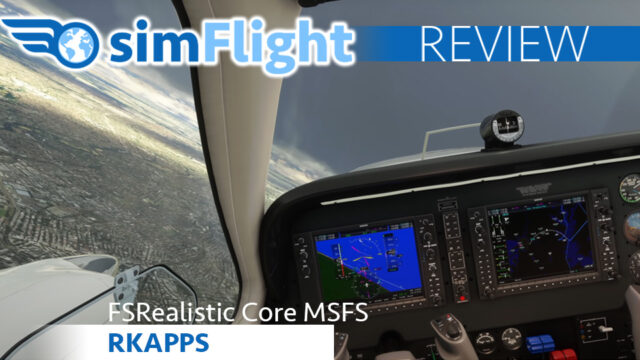
With FSRealistic, rkApps has presented a (partial) transfer of the XPRealistic add-on popular with Xplaners, reminding FSXers of AccuFeel, distributed by A2A at the time. The promise is a more realistic flight experience through more authentic sounds and vibrations of the view, later head movements are to be added, to which the SDK of MSFS does not yet allow access. Michael Kalff investigates whether the self-assured price of over €21 is justified.

What is promised
Actually, ASOBO as the developer of MSFS promised in its promotional videos an elaborately generated, carefully composed, highly detailed programmed, ultra-realistic sound experience … so I was surprised about the announcement of rkApps to launch an immersion addon almost exclusively based on sounds. For 28 aspects there are sounds or microvbrations of the visuals …and all that frame-friendly, for all aircraft in MSFS (also 3rdParty), with support for a buttkicker, compatible with head-tracking. The programme starts itself with the MSFS and offers various possibilities to adapt the effects to one’s own preferences, as well as access to many profiles created by users in the cloud. You can test it for 7 days free of charge, only then you have to decide to buy it – that is also self-confident.
What you get
You download about 400MB, which you can unpack somewhere – saving hard disk space for the MSFS – not necessarily in the usually well-filled community folder or on drive C. Then about 1.1GB unfold – almost all of it is the exe file – and also a manual in English. But using it is totally uncomplicated: start MSFS, create a flight, fly! FSRealistic does everything else by itself first, it starts with the MSFS and activates the profile saved to the aircraft itself when a flight loads. That’s how I like it – an addon should work, not stop you from flying 😉
First of all, I don’t notice anything about the new immersion – I expected an aha-experience, like back then with AccuFeel: you slid open the window and heard the “outside” much louder, sounds when taxiing, braking, head movements … the whole experience became much more physical. On Microsoft planes, there are no windows to slide open (except for Ju52), not even the doors can be opened. And otherwise? First of all, everything feels “good”, normal. It’s like starting the engine in an aeroplane, taxiing to the runway, lining up, giving thrust, putting your nose in the air…. . Doesn’t FSRealitic work?
Yes, the programme runs, has a connection to MSFS… I turn down the volume of the effects …and …aha… now I become aware of the FS-Realistic effect. Everything felt completely natural, was immediately coherent… and with the FSRealistic turned down, only now does the MSFS “pure” seem like a concert muffled with earplugs: dull, undifferentiated. I’m amazed that I hadn’t noticed this on the MSFS before, I feel like a grandfather who recently got a hearing aid and only now realises how intelligently his grandchildren are chatting with him! You don’t miss FSrealistic until you’ve heard it once: Airflow, rolling noises, landing gear hitting the ground, air friction from landing gear, flaps, air brakes, wheel brakes … Every now and then something rattles in the aircraft, the co-pilot sneezes.
For the review I check all effects on different aircraft:
Airframe wind: in real, the airframe wind is quite distinct, unfortunately underrepresented in MSFS and offered in six different variants with FSRealistic. The preset strength also varies in the profiles; both can be “screwed” for individual listening needs and saved for a self-made profile (or load those of other users via the cloud and try them out). However, opening the window in flight (Ju52) does not produce the expected storm noise, as AccuFeel was able to do. FSRealistic focuses on airflow noise during flight manoeuvres.
Auto speedbrake: on Airbuses and Boeings the airbrake is automatically released at touchdown, the bright whirring sound when the lever is electrically lifted is familiar from good add-ons – and now from FSRealistic.
Blade slapping: Lifting crawling in helicopters … the sound package of the H135 has always been a bit “foehny” to me, with FSRealistic there are now impact noises and vibrations (the whole image shakes) when the rotor blades are heavily loaded. These are nowhere near as bassy as I know from the H135 under real load, but still … an acoustic reaction to flight manoeuvres enhances the simulation experience. Adjustable are vibration strength, volume and type of impact noise – named after helicopter types (I would have wished for the Airframe wind and other sounds, too!) – from the AS35 to various Bells, the CH47, the legendary Huey, up to MD500, UH-60 and Robinson, all typical and recognisable, even if a bit high-pitched and underbassing … The H135, of all things, is missing as a variant, and is assigned the Robinson sound by default, which doesn’t fit at all. The H135 rarely slapps, but still… blade slapping is active in the H135 profile and sounds uncharacteristically sharp.
Brakes: Squaeeeeek …no, not quite, but close: rough grinding noises from the wheel brakes in three variations.
Cockpit ambiance: Four different signs of life from the neighbouring seat, when trying out I didn’t hear much of it though, apart from sneezing … and noticed how one cringes inwardly since Corona.
Crash screaming: Macabre …and I’m not entirely comfortable with it: before impact, co-pilot and/or passengers screech a “final scream” (seven variants). Gives an eerie goosebump component to the “final moment” when the lights go out during the MSFS crash. Certainly goes well with Halloween.
Engine start: Eight different sounds from the engine shaking on takeoff and vibrations, naming by type would be more helpful.

Engine vibrations: Simulates the effect of an increase in engine power as vibration…i.e. as trembling of the visual. Adjustable is the basic RPM.
Flaps drag: Simulates the noise of the airflow at the flaps, 10 numbered variants, volume variable – here it would be helpful to assign the variants to aircraft types.
Flaps lever: Four variants of the sound of the flap lever, volume variable. Here, too, named aircraft types instead of numbers would be better.
Flaps stress: Vibrations and either 10 different friction or 13 different shaking noises at the flaps when exceeding the permissible airspeed, volume and vibrations variable. It would be cool if the programme would switch from friction to shaking by itself, depending on the amount of airspeed exceeded, and if the variants were named according to aircraft types. The selection of 23 different sounds sounds good at first, but also overwhelms.
Floats splash: three different sounds of floats on water, much better than MSFS! Variants 1 and 2 are almost drowned out by recorded engine sounds, but variant 3 is great… in the basic setting FSRealstic chooses one randomly, water is different depending on the swell.
Gear drag: Air friction of the extended landing gear, 10 numbered variants (again not by type), volume variable.
Ground effect: The amplification of the engine noise reflected by the ground is promised. However, the variants are called “Wind 1” to “Wind 6” – and are the same sounds as with the Airframe wind. This is surprising… Instead of this (if it is possible from a programming point of view), the aircraft’s own engine sound could simply be amplified?
Ground roll: For me, this is actually the most noticeable difference that FSrealistic makes: Vibrations and randomly selected taxiing, take-off and landing noises among five taxi wax sounds and seven runway sounds (each of which has different characteristics at different airfields).
Landing claps: A, it seems to me, German peculiarity – applause after landing. 6 different variants, among which FSrealistic randomly selects one, but also fixed, volume variable, as with all sound effects of FSRealistic.
Over G: FSRealistic randomly selects one among five types of load groan. This should not occur in normal operation with airliners or GA aircraft, but with aerobatic or fighter aircraft one reaches such limits. The effect is then clear, and it is advisable to simulate with headphones – because only men moan in all five variants – and if someone in the room hears moaning from the computer, very wrong associations can quickly arise, red ears included. Accu-Feel had one more enhancement: if the Over G was sufficiently strong or long, the blood sank away, the pilot became unconscious: the screen first turned red, then black, while the plane continued to fly without any visible control. Only after recovery did the picture come back. In addition, AccuFeel also knew oxygen deficiency at altitudes above 10,000 feet – if the cabin pressure was not sufficient, the oxygen was not activated, the pilot lost consciousness until there was enough pressure to breathe again.
Overspeed: Here, sounds from the same set of friction or shaking noises are used as in flaps stress, and also vibrations. And here, as above, it would be cool to name the sounds according to aircraft type and to increase them according to the amount of overspeed. Whereas the crash detection of the MSFS doesn’t take long at overspeed anyway … pretty quickly “isch over”.
Reverse thrust: Also one of the clear improvements with FSRealistic – Turboprop Reverse Thrust Sound (variant 1) or Jet Revers Thrust Sound (three further variants) increase the immersion. They are also set quite loudly in the default settings.
Sneezing: Small Corona horror – the pilot sneezes on four different variants, with vibration, randomly selected in the default setting. And stupid when landing…
Speedbrakes drag: Same set of 23 friction and shaking noises as flap stress and overspeed, but set quieter. Again would be cool to program this speed dependent.
Stall buffet: vibration and again the same sound set, now set much louder for the stall experience. For me, the basic settings of FSRealistic were the least convincing on the GA machines in the test, there was not much, AccuFeel was much more impressive.
Stick shaker: Three variants of shaking noises from the stick shaker as a stalling warning, of which only variant 1 convinces me, variants 2 and 3 could also be kitchen mixers.
Touchdown: A real improvement. 13 different touchdown sounds and – here really immersive – vibration deepen the experience a lot. Here, too, there is a lack of names to make it easier to assign the touchdowns, which represent everything that flies from “small” to “very large”. Even a random assignment would make sense, each touchdown is different (surface, wind, sink rate and groundspeed…), but here of all places this is not possible!
Turbulence:. Again the 13 shaking noises, but set louder. Makes turbulence more noticeable, which was previously not so intensely perceptible in the MSFS.
Wheel well: Seven types of spinning wheels after takeoff, from very small to very large. Again, there is no identifying name, only numbers. But the effect itself is the point … it was not perceptible in the MSFS until now, that’s why you don’t have the movement in your blood: wheel brakes kick in AFTER take-off.
Wind ambience: only active in the outside view on the ground, wind noises. Six types, randomly generated, correlated with current wind speed.
Windshield wind: Relevant in reality, very discreet in MSFS, finally clear with FSRealistic and one of the really good features – the six types of wind noise also used in “Airframe wind”, now quite concisely audible with increasing speed.
Personal preferences can be set in the FSRealsitic window, which starts automatically with the MSFS and always remains open in the background; many effects can be auditioned. In forums, users with 4k resolution report that the window with its texts becomes too small for comfortable operation.
Because all this is for the ears only, this is the review with the fewest photos of my short simFlight career. But others have made the effort of video reviews, here you can listen to the effects:
What it brings – Conclusion
First of all, FSReaslistic feels “natural”, as if the sounds have always belonged to the simulator … like a pair of new shoes that fit perfectly: you don’t notice them, but they run much better. So the sounds fit authentically into the simulator. There is no wow effect, but once used to it, you notice that the MSFS “doesn’t feel so right” without them. Except in special situations (overG, overspeed, landing, or just before the crash) FSRealistic does not attract extra attention, but completes the experience. The user-friendliness is also nice – just unpack and fly. There would be room for improvement here and there – in the helicopter sounds, in the naming of the sound packages, in the automatic of stronger sounds the more the aircraft is stressed. The pre-mixing of the profiles does not always seem coherent or successful to me, many effects also come across as too quietly set.
Many users will appreciate the innumerable possibilities to adjust the profiles to their own taste; FSRealistic is much more advanced than AccuFeel was back then. The possibility of loading the profiles of other users from the cloud, so that you don’t have to do all the work yourself, is also convincing.
I am still undecided about the camera effects – the vibration of the visuals. It makes sense mentally, but the effect is not really immersive for me. Perhaps it would be better if the cockpit vibrated more and the landscape less? Unfortunately, other camera effects are completely missing – due to the SDK.
One thing remains – the price. The free trial period of one week is very fair – so everyone can find out for themselves what difference FSRealistic makes. Whether the added value is actually more than 20 euros is something you have to decide for yourself. rkApps is oriented towards the XP variant of the add-on – which I find wrong. XP is the platform for flight simulation enthusiasts who invest a lot of time and money in their hobby. MSFS is a much more general offer, which firstly appeals to many more users and then also to younger users and gamers, for whom 20 euros is a sound barrier – for that, something has to be offered. rkApps sets unnecessarily high hurdles with its price in my eyes. But this is probably also a test for the providers to find out where the “sweet point” lies in the optimisation between high sales figures and revenue per unit sold.
Info
| Pro | Contra |
| Sounds blend authentically into the sim action, enhancing the experience Many setting options Profiles of other users accessible from the cloud Free test week | The large variety of sound options is not sorted by aircraft type Lack of H135 sounds Relatively high price |
| Buy | Test System |
| e.g. simMarket Developer: rkApps Price: just over 21 € | IntelCore i5-10600K CPU @ 4.10GHz GeForce RTX 3070, 8 Gb Windows 10×64, 16 Gb main memory Various SSD |
Dr. Michael Kalff translated by deepl.com







